If you’re in search of a mindfulness and meditation app, you’ve probably heard of Headspace. The popular wellness app ranked 4.8/5 on the App Store was founded by a former Buddhist monk, Andy Puddicombe, together with Richard Pierson in 2010 to “improve the health and happiness of the world.” Offering an array of mental health resources such as guided meditations, podcasts, and techniques, the widely recognized app has over 70 million members across 190 countries.
Table of Contents
The History of Headspace
Headspace originally began as a meditation events company in 2010 after Andy Puddicombe and Richard Pierson met in one of Puddicombe’s mediation classes. United by their shared vision of global mental wellness, the two formed a business partnership and launched the initial version of the app in 2012 after increased demand from attendees. Two years later, the two launched an upgraded version.
Throughout the years, Headspace has continued to spread its mission through partnerships across various sectors. In addition to its consumer version, the company also has introduced specialized initiatives like Headspace for Employees and Headspace for Teens.
Timeline:
- In 2016, Headspace began a mission to ease flight discomfort by partnering with seven airlines, Virgin Atlantic being the first.
- During the same year, Headspace became Spotify’s first bundling partner, enabling users to subscribe to both services simultaneously.
- In 2017, the company began the acquisition of corporate subscribers, including industry giants like Google and LinkedIn.
- In 2018, Headspace officially registered Headspace Health as a subsidiary under the Federal Drug Administration. This move would allow the company to fight a range of medical conditions through prescription-strength meditation apps.
- In 2021, Headspace partnered with Ginger, an online management platform, increasing the company’s worth to 3 billion dollars.
- Later, in 2021, Headspace announced the new initiative Headspace for Teens in partnership with the nonprofit Bring Change to Mind and Pear Health Exchange.
- 2023: Headspace unveils its international expansion of on-demand health coaching, therapy, and EAP, Employee Assistance Program, services for employees starting with the United Kingdom.
How Headspace works
Headspace operates as an essential mental health resource, demonstrated by its feature-packed, user-friendly design. Users are prioritized through a personalized daily track and endless amounts of comprehensive mental wellness content, including podcasts, guided meditation, and the company’s coined “sleepcasts.” Additional features like mental wellness notifications and guest passes further prioritize users’ mental health.
Users gain access to activities and videos through their daily routine or the explore page. Activities can be found in Guided Programs or through tags. The time length of completing materials ranges from Learning the Foundation’s 1-minute videos to Guided Program’s 20-minute lessons. Subscribers have access to longer material.
● Content types
Headspace allows users to incorporate a range of content in their daily routine that can be easily accessed through the homepage, tags, or the search bar. Users can incorporate meditations, podcasts, sleepcasts, and animations into their daily routines. Through the explore page, users gain additional options for curated music playlists, exercise videos, animations, and Guided Programs.
The time length of completing materials (during the free trial) spans from Learning the Foundation’s 1-minute videos to Guided Program’s 20-minute lessons. Playlists can last up to an hour, while audios of different environments, such as the laundromat, can span up to 8 hours.
For subscribers, longer, extensive content is available.
● Daily Routine
Upon opening the app, users are welcomed with a daily routine screen that serves as the homepage to begin their daily meditation journey. During the sign-up process, users complete a questionnaire that customizes their daily routine to their individual preferences and needs.
The daily journey is divided into three segments: mornings, afternoons, and nights. Typically, each segment consists of 2-3 activities totaling approximately 7-8 activities offered per day. These activities are a mixture of meditations, videos, podcasts, and one sleepcast. A noteworthy aspect of the daily routine is users have the freedom to engage with the activities in any order. The app doesn’t restrict users to specific activities based on the time of day. For instance, individuals working late shifts or nontraditional hours can access the nighttime material at their convenience.
*Users’ desire to revisit an activity can be achieved through the clock icon at the top right of the screen or their profile.
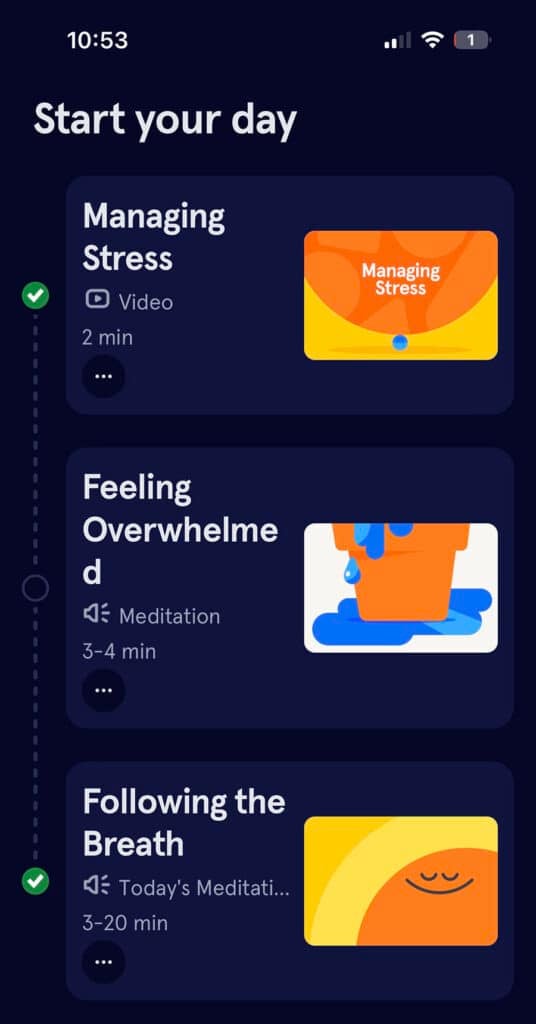
● Modules
Headspace’s comprehensive content is organized into modules that can consist of 8 or more sessions that are between 3 and 20 minutes. Modules cover a wide array of topics, from personal mental wellness to parenting, academics, and national parks.
These specialized lessons feature material from celebrities and household names like Pharrell and the WNBA. It also features material about diversity and inclusion and cultural practices such as:
- Navigating Injustice focuses on” voices with diverse perspectives to help us recognize our differences, struggles, and unique journeys.”
- National Park Collection explores “meditations and sleep content set in iconic national parks-plus, exercises to help you connect with nature wherever you are.”
● Guided Programs
Headspace offers a small selection of Guided Programs within the app designed to help users create life-long habits over the course of weeks. Guided Programs leverage the mindful reminders feature to remind users to dedicate 10-15 minutes at the scheduled time.
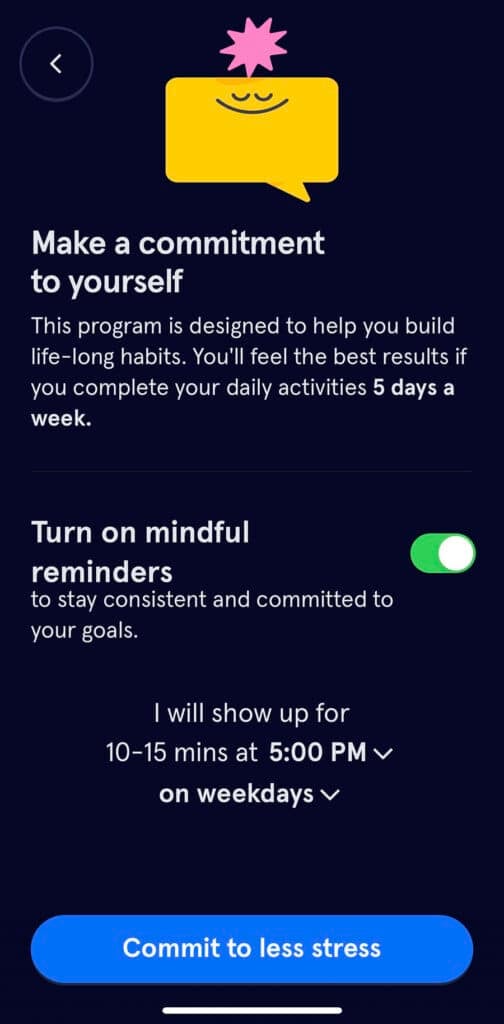
● Notifications
Headspace’s notification options are ideal for those who seek daily encouragement and uplifting. Options include mindful moments, “daily messages to keep you mindful throughout the day,” or reminders for meditation, bedtime, and waking up. One notification that stands out is Headspace’s wind-down reminder, which reminds you to prepare for bed 30 minutes before your bedtime reminder.
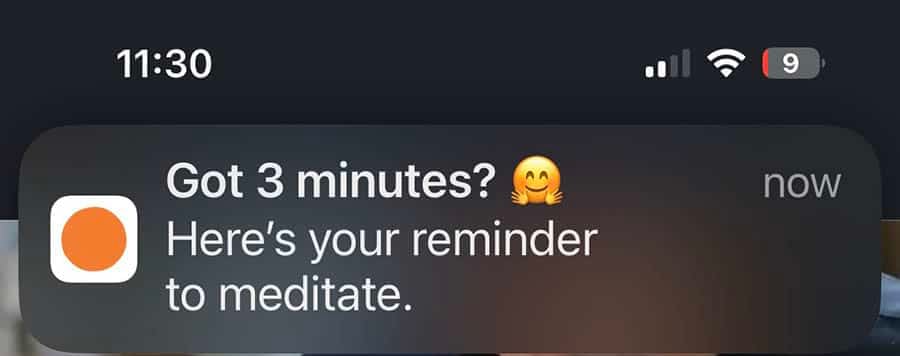
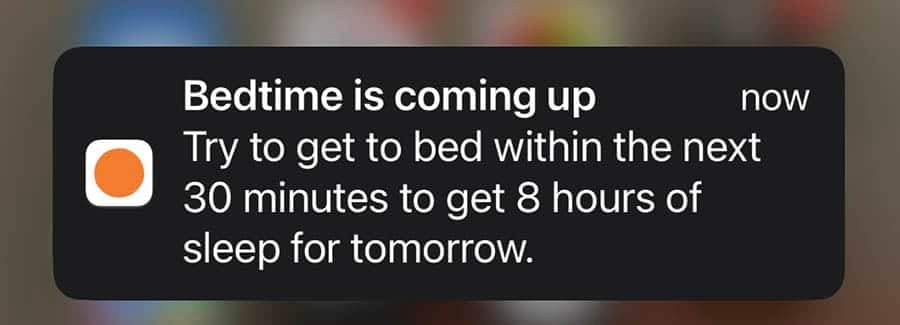
● Guest Pass
Users can help friends, family members, classmates, or anyone they please destress through a 30-day guest pass. After the 30-day trial, guests can continue to access Headspace content at the yearly rate of $12.99 per month.
● Stress Tracker
Headspace allows users to monitor their monthly stress tracker using PSS, the Perceived Stress Scale. Each month, participants have the option of responding to a series of 10 questions and an optional journey entry based on last month’s experience.
Pricing
Headspace offers two billing options: annual and monthly. The annual plan is billed $5.83 US dollars a month for a grand total of $69.99 per year. Users are given a 14-day free trial with this plan. The monthly plan is billed $12.99 US dollars a month, for an approximate total of $155.88 per year. Users are given a 7-day free trial with this plan. The cost difference between the plans is $85.89.
After the free trial, subscribers gain access to longer, more extensive content.
It is notable to add that Headspace for Students is available for free.
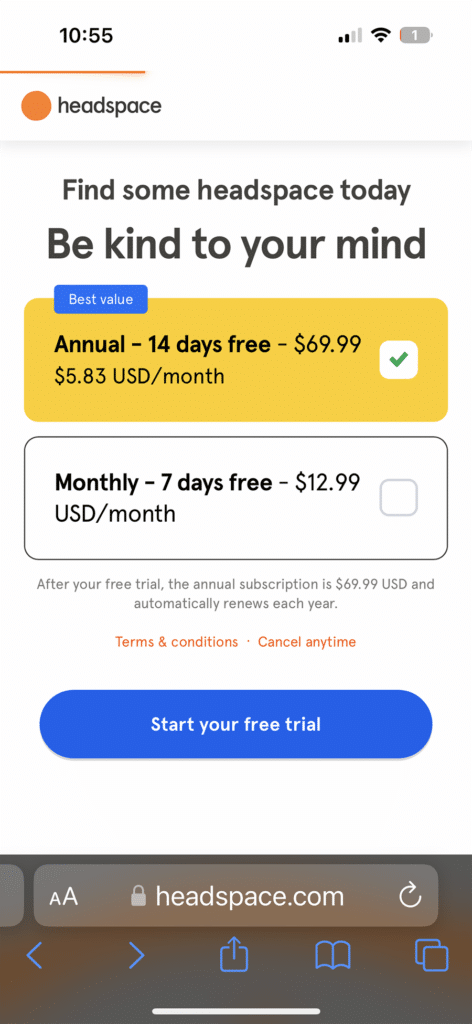
An unexpected but appreciated feature of Headspace is the ability to use PayPal as a payment method. For most subscription services, the alternative payment method to credit and debit cards is Apple Pay. The option to pay with PayPal allows me to track my expenses easily, similar to using a debit or credit card. Apple Pay can be tougher to track expenses because of the prolonged user journey to the subscription section in the App Store.
Pros and cons
My experience
My journey into mindfulness and meditation began about a year ago, primarily driven by my experiences with anxiety attacks, excessive overthinking, and sleepless nights. Initially, these instances were originally addressed through therapy sessions; however, my therapist and I have since parted ways.
As I navigated this journey alone, I explored various solutions like sleep supplements, podcasts, and the mindfulness apps Stellar Sleep by Harvard University and Smiling Minds. While these apps assisted with some of my struggles, neither of them fully addressed my concerns. I needed a mental wellness tool, centralized resources, and help to improve my sleep routine.
During my two-week trial period with Headspace, I was already a month into my new mental health routine. This routine included drug-free sleep supplements and vitamins and occasionally reliance on podcasts to manage anxiety and overthinking. While my new mental health routine was effective, staying consistent proved to be tougher than I imagined.
I still struggled with nighttime rumination, sometimes even after taking supplements. The sleep-inducing audiobook I purchased from Amazon didn’t always help, either. To counter this, I often increased my screen time, using it as an alternative to watching television. Unfortunately, this bad habit kept me awake for hours.
Pros
During my assessment of Headspace, I found the standout features to be:
- Helpful animations
- Mindfulness notifications
- Personalized daily routines
Abundance of helpful animations
One of the most beneficial features of Headspace, in my experience, is the pairing of animations with the meditations and the accessibility of mindfulness videos. Unlike the mindfulness apps I’ve encountered, Headspace uses almost hypnotizing animations in their meditations. These animations, inspired by nature or shapes, move in and out or up and down like a heartbeat as you listen. They serve as concentration mechanisms that allow you to focus on the topic. In the past, I often struggled with maintaining focus during meditation and while listening to podcasts. I’d attempt to focus on an object; however, my mind would wander. In addition to focusing, the animations also were effective in helping me fall asleep as they often lingered in my mind.
Mindfulness notifications
Another strong feature of this app is the variety of mindfulness notifications Headspace offers. Upon signing up for this app, I was given an option to sign up for notifications. Within Headspace, notifications can serve as
- sleep reminders
- meditation reminders
- inspirational quotes during set times of the day
- good morning
For me, these notifications play a crucial role in positive thinking and habits. I especially appreciate the mini mid-day journal prompts, which allow me to reflect on the day even though I have a busy schedule. The wind-down reminder has also played a significant role in my life. In the past, I’ve attempted to set timers to help me fall asleep; however, I was always met with little success. Headspace’s wind-down timer has allowed me to create a structured bedtime routine, which has set the tone for my nighttime animation or yoga video. Paired with my sleep supplements and animation, it has significantly improved my sleep hygiene.
Daily Routine
The final notable feature of Headspace is the personalized daily routine, which I find [very] valuable. The app creates a daily roadmap based on user-provided information. In the past, I longed to include meditation in my morning routine but found it challenging. Sifting through podcasts and YouTube videos wasted a lot of my morning screen time. I also lacked the expertise to curate the correct routine-something my therapist had previously done. Headspace’s daily routine feature addresses my personal concerns while allowing me to access relevant content without the hassle.
Cons
Though Headspace offers a multitude of standout features, there are some drawbacks:
- Too short trial period
- Sedative effect not suitable for daytime use
- Insufficient journal prompts
Trial period limitation
While the trial provides a glimpse into the app’s features, it is relatively short, lasting either 7 or 14 days, depending on the chosen subscription. This time period doesn’t allow users to explore all of its features extensively and is relatively short compared to other apps like Stellar Sleep by Harvard.
Sedative effect
While the soothing audio and sleepcasts are beneficial, they cause sedation, which goes beyond relaxation. Though this is ideal for nighttime, it can be a drawback if you’re looking to finish out your day focused and energized.
Minimal journal prompts
Headspace offers some journal prompts, mainly during the mid-day notifications. However, the selection of journal prompts is limited and doesn’t pertain to every user’s situation.
Overall verdict: Is Headspace worth it?
Headspace is undeniably worth its price, which is why it’s a top choice among mental wellness, meditation, and mindfulness apps. It not only ranks as one of the most popular options in the niche but also stands out for its affordability and its abundance of features.
Headspace’s price point is commendable, with a yearly subscription priced at $70 or a monthly plan at $12.99 per month. Other apps have price tags that exceed well over $100 for a year (or are free with the price tag being restricted to lower quality resources).
Headspace is more than just a mere app; it’s an all-inclusive sidekick, ready to support you through the many avenues of life. The all-inclusive app’s many resources allow users to curate their own journey in addition to their personalized daily routine. The app also fosters a sense of community and can be paired with Apple Health, thus demonstrating its holistic approach to mental health.
User-friendliness is another remarkable aspect of Headspace. Its visual-heavy design is easy to navigate, which ensures accessibility for everyone. Whether you’re a student or anyone seeking to better their mental health, Headspace proves to be an essential tool.
Headspace isn’t just an app; it’s a comprehensive solution to enhance your mental wellness.




